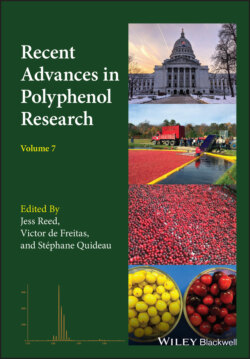Читать книгу Recent Advances in Polyphenol Research - Группа авторов - Страница 35
2.3.5 Annulation Approach (Route III)
ОглавлениеFor the direct construction of the characteristic dioxabicyclo[3.3.1]nonane skeleton, a pioneering approach was reported by the annulation of flavylium ion 22 with phloroglucinol as a nucleophilic unit to form 23 (Figure 2.14) (Jurd and Waiss 1965). Treatment of flavylium salt 22 with phloroglucinol in aqueous MeOH under weakly acidic conditions (pH 5.8, 60 °C, 15 minutes) gave, after acetylation, the annulation product 23 as colorless prisms (23% yield). The stereochemistry was not clarified.
A similar reaction was reported by Pomilio et al. (1977) (Figure 2.15), carrying out the annulation of flavylium 24 and (+)‐catechin under mild acidic conditions (pH 5.8). The reaction was sluggish, and isolation of the product after thorough protection of hydroxy groups resulted in a poor yield of annulation product 25.
Kraus et al. (2009) improved this reaction (Figure 2.16). Treatment of flavylium salt 24 with phloroglucinol followed by treatment with silica gel gave the annulation product 26 in good yield. Moreover, use of (+)‐catechin as a nucleophile gave a diastereomer mixture of two annulation products 27a and 27b in 89% combined yield. Recently, another research group reported a similar protocol (Alejo‐Armijo et al. 2018).
Figure 2.14 Direct annulation approach to the A‐type structure.
Figure 2.15 Early studies on annulation reaction of flavylium 24 with (+)‐catechin.
Figure 2.16 Annulation reaction by Kraus.
An asymmetric version of this approach appeared recently by using a salt of binaphthol‐derived chiral phosphoric acid as a chiral phase transfer catalyst (Figure 2.17) (Yang et al. 2016). Reaction of flavylium salt 28 with phloroglucinol derivative 29 in the presence of A as a catalyst (10 mol%) allowed the enantioselective nucleophilic attack of 29 to the C(4) position of 28 to give adduct 30, which was treated with p‐toluenesulfonic acid to give bicycle 31 in 56% yield with a high enantioselectivity (94% ee).
Figure 2.17 Asymmetric annulation approach.
Figure 2.18 Strategy for stereoselective annulation.
The present authors' group recently developed a novel concept in a flavan annulation (Figure 2.18) (Ito et al. 2014). Two requirements en route to the requisite dioxabicyclic skeleton include (i) design of a suitable precursor I to generate the dicationic species II, and (ii) regioselective dual bond formation with III via mode A, not vice versa (mode B). An additional requirement was the stereoselectivity. Thanks to the C(3) stereocenter in II, the annulation would proceed in a stereoselective manner.
As a dication equivalent, two oxygen‐based leaving groups X at the C(2) and C(4) positions were envisioned, and the precursor I could be available by oxidation of flavan derivatives. Thus, the oxidation of epicatechin derivative 32 with DDQ in the presence of ethylene glycol gave 2,4‐ethylenedioxy derivative 33 in 69% yield (Figure 2.19). The C(8) position of 33 was masked by a bromine atom, affording bromide 34 in excellent yield.
As a model study using the dication precursor 34, the reaction with phloroglucinol derivative 35 was examined in the presence of BF3·OEt2 (Figure 2.20). Upon the reaction started at –78 °C followed by gradual warming, the starting material 34 was consumed at –40 °C, and two products were produced (run 1, Table 2.1). The major product was single‐linked compound 36 with the C(4)–C(2) bond, whereas the minor product 37 had the desired dioxabicyclic structure. Importantly, these products, 36 and 37, were the single stereoisomers, respectively. Re‐exposure of 36 to the same conditions led to a smooth conversion into 37. Thus, the annulation proceeded in a stepwise manner, starting with the formation of the C(4)–C(2) bond from the β‐side to form 36 followed by the C(2)–O bond formation to give 37. Indeed, by extending the reaction time and raising the temperature, the annulation of 34 and 35 went to completion, giving 37 in excellent yield (run two).
Figure 2.19 Synthesis of a 2,4‐dioxy flavan derivative.
Figure 2.20 Model study for stereoselective flavan annulation.
Table 2.1 Results of flavan annulation.
| run | time / h a) | temperature / °C | product (yield) |
|---|---|---|---|
| 1 | 2 | −78 → −40 | 36 (66%), 37 (20%) |
| 2 | 3 | −78 → −20 | 37 (93%) |
a) Duration of the gradual warming.
